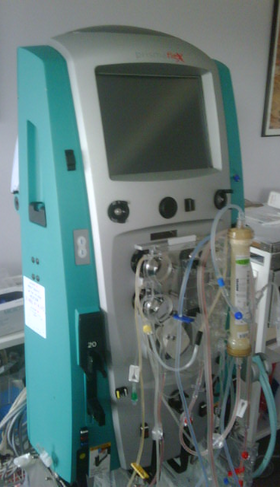
Back ترشيح الدم Arabic Hemofiltración Spanish Hémofiltration French Hemofiltratie Dutch Hemofiltrácia Slovak Hemofiltracija Serbian
| Hemofiltration | |
|---|---|
 Hemofilter ready for use. | |
| Specialty | Nephrology |
| ICD-9-CM | 39.95 |
| MeSH | D006440 |
Hemofiltration, also haemofiltration, is a renal replacement therapy which is used in the intensive care setting. It is usually used to treat acute kidney injury (AKI), but may be of benefit in multiple organ dysfunction syndrome or sepsis.[1] During hemofiltration, a patient's blood is passed through a set of tubing (a filtration circuit) via a machine to a semipermeable membrane (the filter) where waste products and water (collectively called ultrafiltrate) are removed by convection. Replacement fluid is added and the blood is returned to the patient.[2]
As in dialysis, in hemofiltration one achieves movement of solutes across a semi-permeable membrane. However, solute movement with hemofiltration is governed by convection rather than by diffusion. With hemofiltration, dialysate is not used. Instead, a positive hydrostatic pressure drives water and solutes across the filter membrane from the blood compartment to the filtrate compartment, from which it is drained. Solutes, both small and large, get dragged through the membrane at a similar rate by the flow of water that has been engendered by the hydrostatic pressure. Thus convection overcomes the reduced removal rate of larger solutes (due to their slow speed of diffusion) seen in hemodialysis.
- ^ Cruz D, Bellomo R, Kellum J, de Cal M, Ronco C (2008). "The future of extracorporeal support". Critical Care Medicine. 36 (Suppl): S243 – S252. doi:10.1097/CCM.0b013e318168e4f6. PMID 18382201. S2CID 7896249.
{{cite journal}}: CS1 maint: multiple names: authors list (link) - ^ Hoffmann JN, Faist E (2001). "Removal of mediators by continuous hemofiltration in septic patients". World Journal of Surgery. 25 (5): 651–659. doi:10.1007/s002680020027. PMID 11369995. S2CID 10197867.